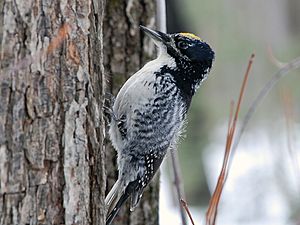American three-toed woodpecker facts for kids
Quick facts for kids Three-toed woodpecker |
|
|---|---|
 |
|
| adult male | |
| Conservation status | |
| Scientific classification | |
| Genus: |
Picoides
|
| Species: |
dorsalis
|
 |
|
| American three-toed woodpecker range. A small portion of the Eurasian three-toed woodpecker P. tridactylus range is visible too. | |
 |
|
| Eurasian and American three-toed woodpeckers ranges. | |
The American three-toed woodpecker (Picoides dorsalis) is a medium-sized bird. It belongs to the woodpecker family and lives in North America. This bird is special because it has only three toes on each foot, unlike most birds that have four.
About This Woodpecker
This woodpecker is about 21 cm (8.3 in) long. Its wings can spread out to 38 cm (15 in). On average, it weighs about 55 g (1.9 oz). In the wild, it can live for up to 6 years.
It looks a lot like the black-backed woodpecker, which also has three toes. For a long time, people thought it was the same species as the Eurasian three-toed woodpecker.
Adult American three-toed woodpeckers have black heads, wings, and backsides. Their throats and bellies are white. The sides of their bodies are white with black stripes. Their tails are black, but the outer feathers are white with black stripes. Male woodpeckers have a bright yellow patch on top of their heads.
Where They Live and Nest
These woodpeckers make their homes in coniferous forests. You can find them across western Canada, Alaska, and the western United States. They have also been seen nesting in Michigan and Minnesota.
Female woodpeckers lay 3 to 7 eggs, but usually 4. They build their nests inside holes they dig in dead conifer trees. Sometimes, they use a live tree or even a pole. The woodpecker pair digs a brand new nest hole every year.
Three-toed woodpeckers really like forests that have been changed by things like fires. They are often found where there are many Spruce Beetles. These beetles infest trees, making them a great food source for the woodpeckers. The holes they dig also help other animals that need tree cavities to live.
How They Move and Find Food
These birds usually stay in the same area all year. However, woodpeckers from northern regions might fly south for winter. Those living high up in mountains might move to lower areas when it gets cold.
American three-toed woodpeckers look for food on conifer trees. They search for insect larvae that live inside the wood. They also eat other insects. Sometimes, they snack on fruit or tree sap.
These birds often move to places where there are lots of insect-filled trees. This can happen after a forest fire or a flood. When they live in the same areas as black-backed woodpeckers, the American three-toed woodpeckers might move to different spots to avoid competing for food.
See also
 In Spanish: Pico tridáctilo americano para niños
In Spanish: Pico tridáctilo americano para niños


